Technology
The Most Valuable Tech Skills in 2017
The Most Valuable Tech Skills
The interactive graphic above comes to us from Dice Insights, and it helps to visualize the relationship between the supply and demand for over 1,400 technology skills.
Specifically, the supply shown on the graph is based on the amount of job seekers with those skills available, while demand is the portion of employment opportunities listed that require that skill. The “hotter” red a skill is, the greater the ratio of demand to supply.
Big Data Heats Up
With billions of new “things” connecting to the IoT and an explosion in the amount of information that must be processed and interpreted, it is no surprise that many of the most lucrative skills in tech today relate to making sense of large volumes of data.
Here are the ten highest paying skills in technology, according to Dice:
| Rank | Skill | 2016 Salary | Yr/Yr Change |
|---|---|---|---|
| #1 | HANA | $128,958 | -3.30% |
| #2 | MapReduce | $125,009 | -0.30% |
| #3 | Cloud Foundry | $124,038 | n/a |
| #4 | Hbase | $123,934 | 5.70% |
| #5 | Omnigraffle | $123,782 | -1.90% |
| #6 | Cassandra | $123,459 | 2.20% |
| #7 | Apache Kafka | $122,728 | n/a |
| #8 | SOA | $122,094 | -1.90% |
| #9 | Ansible | $121,382 | n/a |
| #10 | Jetty | $120,978 | 1.30% |
Leading the list is SAP’s HANA, or “High Performance Analytical Application”, which is part of a new wave of databases that can crunch large amounts of data nearly instantly. The average salaries of workers skilled in HANA currently hover around $129,000.
If we sort the members of the top ten most lucrative skills list by “heat” level (with several omissions according to availability in the “heat data” set) we can see that HANA is right in the middle of the plot, where supply is roughly equal to demand. This shows us that tech workers choosing to skill up in HANA are effectively getting paid what they are worth.

Defining the Essentials
What else does “heat” ranking tell us about the market for tech skills that salary data alone does not?
First and foremost, it shows that skills like Java, SQL and HTML, all of which live in the top right-hand corner of the interactive graph where both demand and supply are very high, have become the “bread and butter” of the tech industry. The vast majority of people in the field have a need for these basic services, and as such, the majority of workers in tech have become conversant in them.
We can also see that specific fields, like database administration, web infrastructure management, automation, and big data science, are the areas that businesses need the most help in. The number of specialists skilled in these fields has not yet expanded to meet the significant demand for the associated skills. On the other hand, many marketing and web design skills have fallen toward the “cold” side of the spectrum as supply exceeds demand.
Competition and Timing
Employers may often look for very specific skill sets including one or more of the “hot” skills in the current marketplace. Combined with a hot technology sector, this demand pushes average salary ranges up and motivates tech workers to continually revise their competencies on a regular basis.

With such a fluid marketplace for jobs in technology, unemployment is very low at around 2%. At the same time, over the past decade, the average tech salary has also increased by roughly $17,000.
Technology
Ranked: Semiconductor Companies by Industry Revenue Share
Nvidia is coming for Intel’s crown. Samsung is losing ground. AI is transforming the space. We break down revenue for semiconductor companies.
Semiconductor Companies by Industry Revenue Share
This was originally posted on our Voronoi app. Download the app for free on Apple or Android and discover incredible data-driven charts from a variety of trusted sources.
Did you know that some computer chips are now retailing for the price of a new BMW?
As computers invade nearly every sphere of life, so too have the chips that power them, raising the revenues of the businesses dedicated to designing them.
But how did various chipmakers measure against each other last year?
We rank the biggest semiconductor companies by their percentage share of the industry’s revenues in 2023, using data from Omdia research.
Which Chip Company Made the Most Money in 2023?
Market leader and industry-defining veteran Intel still holds the crown for the most revenue in the sector, crossing $50 billion in 2023, or 10% of the broader industry’s topline.
All is not well at Intel, however, with the company’s stock price down over 20% year-to-date after it revealed billion-dollar losses in its foundry business.
| Rank | Company | 2023 Revenue | % of Industry Revenue |
|---|---|---|---|
| 1 | Intel | $51B | 9.4% |
| 2 | NVIDIA | $49B | 9.0% |
| 3 | Samsung Electronics | $44B | 8.1% |
| 4 | Qualcomm | $31B | 5.7% |
| 5 | Broadcom | $28B | 5.2% |
| 6 | SK Hynix | $24B | 4.4% |
| 7 | AMD | $22B | 4.1% |
| 8 | Apple | $19B | 3.4% |
| 9 | Infineon Tech | $17B | 3.2% |
| 10 | STMicroelectronics | $17B | 3.2% |
| 11 | Texas Instruments | $17B | 3.1% |
| 12 | Micron Technology | $16B | 2.9% |
| 13 | MediaTek | $14B | 2.6% |
| 14 | NXP | $13B | 2.4% |
| 15 | Analog Devices | $12B | 2.2% |
| 16 | Renesas Electronics Corporation | $11B | 1.9% |
| 17 | Sony Semiconductor Solutions Corporation | $10B | 1.9% |
| 18 | Microchip Technology | $8B | 1.5% |
| 19 | Onsemi | $8B | 1.4% |
| 20 | KIOXIA Corporation | $7B | 1.3% |
| N/A | Others | $126B | 23.2% |
| N/A | Total | $545B | 100% |
Note: Figures are rounded. Totals and percentages may not sum to 100.
Meanwhile, Nvidia is very close to overtaking Intel, after declaring $49 billion of topline revenue for 2023. This is more than double its 2022 revenue ($21 billion), increasing its share of industry revenues to 9%.
Nvidia’s meteoric rise has gotten a huge thumbs-up from investors. It became a trillion dollar stock last year, and broke the single-day gain record for market capitalization this year.
Other chipmakers haven’t been as successful. Out of the top 20 semiconductor companies by revenue, 12 did not match their 2022 revenues, including big names like Intel, Samsung, and AMD.
The Many Different Types of Chipmakers
All of these companies may belong to the same industry, but they don’t focus on the same niche.
According to Investopedia, there are four major types of chips, depending on their functionality: microprocessors, memory chips, standard chips, and complex systems on a chip.
Nvidia’s core business was once GPUs for computers (graphics processing units), but in recent years this has drastically shifted towards microprocessors for analytics and AI.
These specialized chips seem to be where the majority of growth is occurring within the sector. For example, companies that are largely in the memory segment—Samsung, SK Hynix, and Micron Technology—saw peak revenues in the mid-2010s.
-

 Real Estate2 weeks ago
Real Estate2 weeks agoVisualizing America’s Shortage of Affordable Homes
-

 Technology1 week ago
Technology1 week agoRanked: Semiconductor Companies by Industry Revenue Share
-

 Money1 week ago
Money1 week agoWhich States Have the Highest Minimum Wage in America?
-

 Real Estate1 week ago
Real Estate1 week agoRanked: The Most Valuable Housing Markets in America
-

 Business2 weeks ago
Business2 weeks agoCharted: Big Four Market Share by S&P 500 Audits
-

 AI2 weeks ago
AI2 weeks agoThe Stock Performance of U.S. Chipmakers So Far in 2024
-

 Misc2 weeks ago
Misc2 weeks agoAlmost Every EV Stock is Down After Q1 2024
-

 Money2 weeks ago
Money2 weeks agoWhere Does One U.S. Tax Dollar Go?












